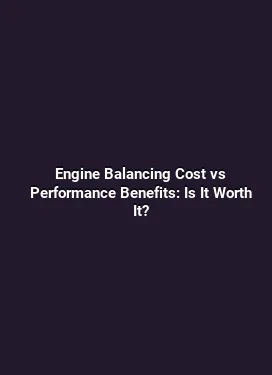Tuning and Emissions: How to Stay Street Legal While Maximizing Performance Gains
Foundations of Legal Street Tuning and Emissions Compliance

Performance enthusiasts often pursue meaningful gains in power, response, and efficiency. However, pursuing horsepower without regard for emissions regulations can lead to legal and warranty risks, failed inspections, and restricted vehicle use. A balanced approach begins with understanding the frameworks that govern street legality, what parts and modifications are typically scrutinized, and how modern engine management systems provide both performance potential and compliance controls. This section introduces the mindset shift from a sole focus on horsepower to a holistic view that couples performance with predictable, legal behavior under real-world driving conditions.
At the heart of street legality lies the ability to demonstrate that the vehicle remains within established exhaust emissions limits, maintains safe engine operation, and preserves drivability. Emissions systems—such as catalytic converters, oxygen sensors, and exhaust gas recirculation—are designed to regulate pollutants and maintain stable air-fuel ratios across a broad range of operating conditions. Modifications that bypass, disable, or falsely alter these systems can trigger failed inspections, warranty voids, and in some regions, penalties. The path to gains therefore starts with a foundation: working within the vehicle’s control architecture to optimize performance while preserving the integrity of emissions control systems.
In practice, this means adopting a disciplined approach to engine management that emphasizes data-driven tuning, certified parts, and compliance-aware strategies. It also means recognizing the difference between street-legal tuning and race-focused work that is intended strictly for track use. Responsible tuning considers not only peak numbers but also how the engine behaves across the entire duty cycle—from cold starts and idling to full-throttle accelerations and steady highway cruising. This comprehensive perspective is essential for consistent performance with predictable emissions behavior.
Engine Management Systems: Core Tools for Power and Compliance
Engine management systems (EMS) are the central nervous system of modern performance tuning. They regulate fuel delivery, ignition timing, boost pressure, valve timing in variable systems, and many sensor-driven corrections. A modern EMS provides a wide latitude for refinement without compromising reliability or legal compliance. The approach outlined here focuses on practical, evidence-based changes that improve power while maintaining stable emissions and drivability.
Key elements of an effective street-legal tuning plan include: selecting a capable but compliant ECU/TCU platform; utilizing precise fuel and ignition calibrations; implementing robust data logging; and ensuring all emissions-related components remain active and controllable. The aim is to improve efficiency and power through intelligent mapping, not by bypassing the feedback systems that monitor combustion and exhaust chemistry. When done correctly, you gain meaningful torque at usable RPM ranges, improved throttle response, and consistent performance under a wide range of temperatures and loads, all while staying within legal boundaries.
Fundamental Components and What They Do

Fuel delivery and ignition timing are the primary levers for increasing power. In a compliant setup, these changes are made with respect to oxygen sensor readouts, catalyst temperatures, and exhaust gas composition. Adjusting fueling without regard to sensor feedback risks rich or lean conditions, which can elevate emissions or trigger misfires. A responsible strategy uses closed-loop control during most operating modes, supplemented by well-calibrated open-loop maps for wide-open-throttle (WOT) scenarios where sensor feedback is temporarily limited or refined to ensure safe operation.
Boost control and turbocharger or supercharger management are powerful avenues for performance gains. However, boosting introduces additional heat and stress on the engine, which can affect emissions and durability if not managed properly. An EMS that supports smooth boost transitions, wastegate control, and intercooler efficiency monitoring helps maintain consistent air density and fuel requirements, reducing the risk of elevated exhaust emissions during pull events or rapid throttle changes.
Trend-Keeping: Data-Driven Tuning and Monitoring
Modern tuning is as much about data as it is about calculations. Trend analysis of sensor data, such as oxygen sensors, intake air temperature, manifold pressure, and fuel trims, provides insights into the health of both the engine and the emissions system. Data-driven tuning uses validated maps and real-time feedback to refine fueling, timing, and boost curves, ensuring that emissions remain within permissible ranges across altitude, ambient temperature, and fuel quality variations. This approach reduces the chance of runaway conditions and supports repeatable performance gains across different driving profiles.
Strategies to Maximize Power Without Violating Emissions Rules
Gaining horsepower while preserving emissions compliance hinges on targeted, well-supported modifications rather than broad, unverified changes. The following strategies emphasize practical steps that deliver real-world performance without compromising legal requirements.
First, focus on air management and combustion efficiency. Improved intake flow, optimized throttle response, and refined cam timing (where applicable) can yield meaningful power with minimal added emissions when paired with proper fueling and timing calibrations. Second, ensure exhaust changes respect the catalytic converter’s operation and preserve O2 sensor feedback. A properly designed exhaust with compliant catalysts and oxygen sensor placements can reduce backpressure without undermining emissions controls. Third, invest in robust data logging and validation to confirm that the tune behaves as intended under diverse conditions and to verify that emission-related health indicators remain within acceptable bounds.
Intake and Airflow Optimization
Increasing intake efficiency reduces pumping losses and can elevate power, especially at mid to high RPM ranges. A compliant strategy prioritizes airbox geometry, intake tract length, and air filter quality while ensuring the mass air flow sensor readings remain accurate. It is crucial to avoid hollow, resonated, or unmetered air paths that can mislead the EMS and disrupt closed-loop fueling. Real gains come from harmonizing the intake with the throttle, intercooler efficiency, and subsequent fueling maps to maintain stable air-fuel ratios across the operating envelope.
Advanced practitioners may explore calibrated charge cooling and intake manifold tuning where available. However, these modifications must be paired with calibrated fuel and ignition maps, as any mismatch can lead to knock, increased emissions, or catalyst damage. The objective is to improve volumetric efficiency and thermal management without creating conditions that stress the exhaust aftertreatment system.
Exhaust System Considerations for Compliance and Power
Exhaust tuning can yield noticeable performance gains by reducing backpressure and smoothing exhaust pulses. When done correctly, a tuned exhaust preserves catalyst efficiency and sensor feedback, which keeps emissions in check. Key considerations include maintaining proper catalytic converter health, ensuring exhaust gas temperatures stay within the catalyst’s operating window, and placing oxygen sensors in positions that reflect actual exhaust conditions. A compliant setup avoids removing or bypassing sensors and does not disable emissions controls. It should also avoid heavy modifications that could render a vehicle unable to pass regulatory inspections or OBD checks.
Fuel Strategy and Combustion Quality
A robust fueling strategy aligns with the engine’s timing and boosted pressures to optimize combustion efficiency. Fine-tuning fuel maps for a safe stoichiometry across idle, cruising, and WOT prevents rich or lean excursions that would elevate emissions. Wideband O2 sensor data, when used in a controlled manner, allows for precise adjustments without compromising compliance. The best practices include validating fuel trims across temperature variations and fuel quality changes, ensuring that catalyst temperatures stay within optimal ranges and that catalytic convertor efficiency isn’t degraded during high-load operation.
Monitoring, Validation, and Real-World Compliance Checks
Ongoing monitoring is essential for maintaining street-legal performance. The most effective tuning regimes feature rigorous validation processes that combine lab-grade data logging with on-road testing. This approach ensures that the power gains do not come at the expense of emissions compliance, drivability, or reliability.
Instrumentation and software tools enable precise trend analysis of key parameters such as air-fuel ratio, knock events, manifold pressure, and exhaust gas temperatures. Regular validation under varying ambient conditions—hot, cold, humid, and dry climates—helps ensure that the tune remains within regulatory limits while still delivering performance gains. It also provides early warning signs if any component of the emissions system begins to drift out of spec.
Dyno runs are valuable for benchmarking power gains and enabling repeatable testing across different fuel grades and environmental conditions. However, street legality hinges on the tune’s behavior beyond the dyno. On-road validation, including 60-to-120 km/h accelerations, steady cruising, and deceleration phases, confirms that the vehicle behaves consistently and that emissions-related feedback loops function correctly in real driving scenarios. It is important to log data during these sessions to verify that the EMS maintains accurate fueling, timing, and boost control while the catalytic converter temperatures stay within designated ranges.
Regulatory requirements vary by region, and a thorough tuning project should account for local laws, inspection criteria, and warranty implications. Maintaining a clear record of parts used, calibration versions, and validation results can simplify inspections and provide a trail proving that emissions systems remain functional. In practice, this means documenting sensor placements, exhaust specifications, and the exact calibrations applied, as well as preserving test data that demonstrates emissions compliance under representative driving conditions.
Practical Roadmap: From Concept to Street-Ready Performance
Implementing a street-legal performance upgrade involves a phased approach that reduces risk and increases the likelihood of durable gains. The following roadmap combines the principles outlined above into a practical sequence that a capable technician or car enthusiast can follow.
- Audit the baseline: Confirm the vehicle’s emissions equipment, sensor health, and software version. Gather baseline data for fuel trims, timing, and boost behavior to identify potential hotspots for improvement without compromising emissions.
- Define performance goals within compliance boundaries: Establish target horsepower and torque ranges, drivability expectations, and acceptable emission indicators. Use these goals to guide the choice of parts and maps.
- Choose compliant hardware: Select intake, exhaust, and forced induction components designed to work with modern EMS constraints and to preserve catalytic converter operation. Ensure all components carry appropriate certifications or are designed to meet regional standards.
- Develop calibrated maps with closed-loop emphasis: Start with conservative modifications and progressively refine fueling, timing, and boost using sensor feedback. Maintain robust protections for knock and pre-ignition across temperature ranges.
- Validate comprehensively: Perform bench dyno tests and real-world driving tests across a spectrum of conditions. Log and analyze data to ensure emissions-related metrics remain within target windows and that performance is repeatable.
- Document and monitor: Keep a detailed log of all changes, calibration versions, and validation results. Establish a routine for periodic revalidation as fuel quality, climate, and altitude change over time.
Emissions Contingencies: How to Respond if Regulations Tighten
Regulatory environments evolve, and what is compliant today may require adaptation tomorrow. Proactive planning includes staying informed about local inspection standards, keeping calibration files organized for future reference, and maintaining a modular tuning approach. If new standards necessitate recalibration or component adjustments, a well-documented EMS that prioritizes sensor feedback and emissions health will facilitate a smoother transition without sacrificing performance gains.
Future-Proofing: Trends in Engine Management and Emission Control
As technology advances, engine management platforms increasingly integrate predictive analytics, machine learning-assisted mappings, and more granular sensor data to optimize performance while preserving emissions compliance. Trend-ready tuning leverages these tools to adjust to fuel quality variability, aging sensors, and evolving regulatory criteria. The practical takeaway is to design tunes around flexible, modular strategies that can evolve with the vehicle’s own telemetry data, rather than rigid, one-size-fits-all mappings. This approach ensures sustained, safe gains that remain legal under changing conditions.
Conclusion: A Balanced Path to Street-Legitimate Performance
The art of street-legal tuning is not about defeating emission controls or chasing peak numbers at any cost. It is about harmonizing power with responsibility—maximizing performance while maintaining safe, predictable engine behavior and ensuring that emissions systems function as intended. By embracing data-driven strategies, compliant hardware choices, and rigorous validation practices, enthusiasts can enjoy meaningful gains that endure across daily driving, seasonal variations, and regulatory landscapes.






